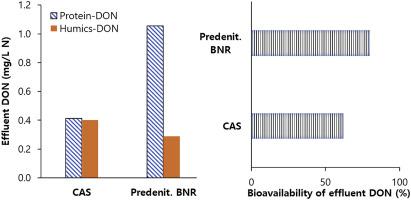Environmental Research ( IF 7.7 ) Pub Date : 2021-02-25 , DOI: 10.1016/j.envres.2021.110912 Heonseop Eom , Chul Park

|
Upgrading wastewater treatment plants (WWTPs) from conventional activated sludge (CAS) to predenitrification biological nutrient removal (BNR) results in improved removal of dissolved inorganic nitrogen (DIN) from wastewater. However, changes in dissolved organic nitrogen (DON) with these WWTP upgrades and their potential impacts on receiving waters have been little researched. In this study, we investigated characteristics of effluent DON derived from CAS and predenitrification BNR, paying special attention to proteins and humic substances. Through a lab-scale reactor study and analysis of full-scale WWTP effluents, we found that in predenitrification BNR effluent, proteins are much more dominant than humic substances, whereas in CAS effluent, proteins and humic substances are similarly abundant. In terms of molecular weight, the majority of proteins were present in the effluent's low molecular weight (LMW) fraction (<1 kDa), while humic substances were found mostly in the effluent's high molecular weight (HMW) fraction (0.45 μm–1 kDa). Determination of dissolved organic carbon (DOC)/DON ratios in effluents supports that proteins (and LMW-DON) were most likely microbial-derived organic N produced during treatment processing, whereas humic substances (and HMW-DON) more likely originated outside of treatment systems. Bioassay tests demonstrated that effluent DON derived from predenitrification BNR was more bioavailable than that derived from CAS. We also found that LMW-DON and proteins were highly bioavailable DON compared to HMW-DON and humic substances. The results of this study suggest that upgrading CAS to predenitrification BNR makes effluent DON to become more conducive to phytoplankton blooms in receiving waters.
中文翻译:

常规活性污泥(CAS)和脱硝化前生物去除(BNR)产生的废水DON的特性研究:就蛋白质和腐殖质而言
将废水处理厂(WWTP)从传统的活性污泥(CAS)升级为预脱氮生物营养物去除(BNR),可以改善废水中溶解性无机氮(DIN)的去除率。但是,由于这些污水处理厂的升级,其溶解性有机氮(DON)的变化及其对接收水的潜在影响尚未得到研究。在这项研究中,我们调查了来自CAS和预脱氮BNR的废水DON的特性,特别注意蛋白质和腐殖质。通过实验室规模的反应器研究和对全尺寸污水处理厂废水的分析,我们发现在预硝化BNR废水中,蛋白质比腐殖质更占优势,而在CAS废水中,蛋白质和腐殖质也同样丰富。就分子量而言 大部分蛋白质存在于废水的低分子量(LMW)馏分(<1 kDa)中,而腐殖质则主要存在于废水的高分子量(HMW)馏分(0.45 μm–1 kDa)中。测定废水中的溶解有机碳(DOC)/ DON比值可支持蛋白质(和LMW-DON)最可能是在处理过程中产生的微生物衍生的有机氮,而腐殖质(和HMW-DON)更可能是在处理之外产生的系统。生物测定测试表明,来自脱硝化前BNR的污水DON比来自CAS的污水具有更高的生物利用度。我们还发现,与HMW-DON和腐殖质相比,LMW-DON和蛋白质具有较高的生物利用度DON。











































 京公网安备 11010802027423号
京公网安备 11010802027423号